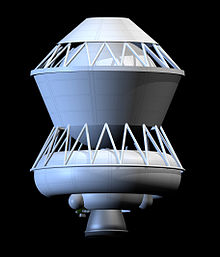 Blok DM | |
| Country of origin | Soviet Union |
|---|---|
| Used on | N-1, Proton and Zenit-3 |
| General characteristics | |
| Height | 6.28 m (20.6 ft) |
| Diameter | 3.70 m (12.1 ft) |
| Gross mass | 17,360 kg (38,270 lb) |
| Propellant mass | 15,220 kg (33,550 lb) |
| Empty mass | 2,140 kg (4,720 lb) |
| Associated stages | |
| Family | Blok D |
| Derived from | Blok D |
| Derivatives | Blok DM-03 |
| Comparable | Briz-M |
| Launch history | |
| Status | Retired |
| Total launches | 66 |
| First flight | 1974-03-26 |
| Last flight | 1988-05-06 |
| Launch date | |
| Blok DM | |
| Powered by | RD-58M |
| Maximum thrust | 83.61 kN (18,800 lbf) |
| Specific impulse | 363.5 s (3.565 km/s) |
| Burn time | 630 seconds |
| Propellant | RP-1/LOX |
Blok D (Russian: Блок Д meaning Block D) is an upper stage used on Soviet and later Russian expendable launch systems, including the N1, Proton-K and Zenit.[2]
The stage (and its derivatives) has been included in more than 320 launched rockets as of 2015[update].[3] By 2002 its modification Blok DM had a 97% success rate in 218 flights since 1974, and 43 successful missions in 1997–2002.[4][5]
The stage was developed in the 1960s as the fifth stage ('Д' is the fifth letter in the Cyrillic alphabet) for the powerful N1 rocket used in the Soviet crewed lunar programs. The stage first flew in March 1967 while testing the Zond spacecraft as a part of those programs. During crewed lunar flight Blok D would be used for mid-course corrections on the flight to the Moon, then to place the lunar orbiter and lander into a lunar orbit, and decelerate moon-lander out onto its landing trajectory.[6]
Blok D was also included as fourth stage of Proton-K and as such flew on uncrewed Soviet missions to Moon, Mars (Mars 3) and Venus. It was used in the Proton-K configuration of the rocket and is still in use in the newer Proton-M variant (along with the Briz-M).
Blok DM also flies as the third stage for the Zenit-3SL rocket, which is used by the Sea Launch project to launch geostationary satellites. In 2002 a Blok DM3 failed in the attempted launch of Astra 1K.
The stage uses liquid oxygen (LOX) and kerosene as propellants, and has one single-chamber RD-58 main engine. The LOX tank has a spherical shape; the kerosene tank is toroidal, inclined to 15 degrees for better fuel extraction, with the engine mounted in the center of torus. Tanks include the first pump stage for the engine; the main pump is mounted on the engine.
Blok D weighs 3.5 tons during liftoff, but some parts are jettisoned and the dry mass in space is 2.5 tons. It has 5.70 meters length and generates 83.300 kN thrust for 600 seconds burn time. Blok D was modified as Blok DM in 1974, with 11D-58S engine. The unit cost is $4 million.[7]
As of the early 1990s, the ullage rockets discarded just before the final burns by Block DM fourth stages on Proton launches constituted the largest single group of soviet propulsion systems to have suffered disintegrations contributing to space debris.[8]
Since 1990, all variations of this stage have been built in the Krasnoyarsk Machine-Building Plant.[9]
- ^ Cite error: The named reference
b14643-protondesignwas invoked but never defined (see the help page). - ^ Cite error: The named reference
rkke-blokdmslwas invoked but never defined (see the help page). - ^ Cite error: The named reference
gsp-blokdwas invoked but never defined (see the help page). - ^ Cite error: The named reference
rsw-n1was invoked but never defined (see the help page). - ^ Cite error: The named reference
boeing-pr2002was invoked but never defined (see the help page). - ^ Cite error: The named reference
asat-11d58was invoked but never defined (see the help page). - ^ "Block DM 11S86". Archived from the original on 23 July 2008. Retrieved 26 September 2008.
- ^ Clark, Phillip. "SPACE DEBRIS INCIDENTS INVOLVING SOVIET/RUSSIAN LAUNCHES". Archived from the original on 25 October 2021. Retrieved 7 February 2023.
- ^ Cite error: The named reference
krasm-blokdwas invoked but never defined (see the help page).